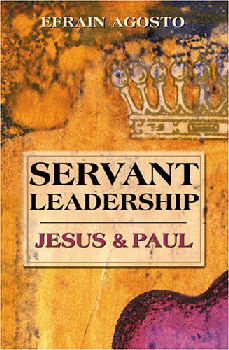
|
Posted April 25, 2006
Book: Servant Leadership: Jesus & Paul Author: Efrain Agosto Chalice Press, St. Louis, Missouri, 2005, pp. 248 An Excerpt from the Introduction:
In this book I explore two models of faithful leadership in the early church – Jesus and Paul, the two major figures of the New Testament. By studying Jesus and his movement, especially as reflected in the synoptic gospels, I explore the pictures and expectations of leadership that emerge from the earliest Christian communities, both at the level of the historical Jesus, and the later gospel writers. The apostle Paul, his churches, and his leaders will occupy a major portion of the study. Given the questions of modern congregational leadership, some very fruitful conversation can take place with the Pauline correspondence. Those concerned with the qualities of a church leader, the development of leaders, and the legitimate functions of leadership will benefit immensely from a careful review of what Paul writes and practices in these areas. Paul’s letters reflect his work with actual congregations; and to the extent that we can determine his approach to various conflicts in those congregations, we can see more clearly the leadership qualities needed to address similar concerns in our own day. An Excerpt from the Book: This brief overview of the rest of the New Testament suggests that models and approaches to the leadership task in the Jesus movement in the decades following the ministry of its founder, Jesus of Nazareth, and of its most significant missionary, Paul the apostle, varied depending on the community, its needs, and the attitudes of its immediate leaders, theologians, and authors. The core values of justice, concern for the poor, and open access to leadership that identified the leadership of Jesus and Paul diminished in some quarters as the different communities sought to adjust to their specific situations. Some focused on other values such as correct teaching and personal morality so as not to draw too much attention to the Christian community’s presence in a particular region. Others turned inward to deal with internal dissension and leadership structures. All continued to focus on Jesus but developed a variety of christological formulations to explain the meaning of Jesus for their own times and situations. What will be our legacy for the practice of religious leadership today? Will the concerns of the poor and those without status continue to drive our leadership practices like they did for Jesus and Paul? Will we confront entrenched power like Jesus did and like the communities represented in the book of Revelation tried to do when such power practices injustice? One hopes that religious leaders will always promote peace and justice in the world, and not only when it is convenient, that we will not accommodate so much to our context in hopes of maintaining the status quo — as the authors of the pastoral and, to some extent, 1 Peter did – that we lose sight of the prophetic leadership exemplified by Jesus and Paul in dealing with the outside world. Nor should we fight so much among ourselves, as the Johannine communities and the communities represented in 2 Peter and Jude did at various points in their histories. And may we always have Christian leaders who promote peace and reconciliation with other faiths, not demonize them, as the author of John’s gospel seems to have done when he called his community’s opponents “the Jews,” as if that entire community was to blame for the struggles of the Johannine community at that point in its history. We all know the sad legacy that such a leadership practice, labeling a whole people as one’s enemies — whether Jews, Muslims, or Christians — has left throughout history. Religious leaders can and should do better than that. Table of contents: 1. The world of Jesus and Paul 2. Leadership in the synoptic tradition: discipleship, mission, and audience 3. Leadership in the synoptic tradition: failure of established leaders 4. Windows into Pauline leadership 5. Paul’s leaders 6. Problems in leadership: Corinthian correspondence Conclusion: summary of leadership in Jesus and Paul |
|
